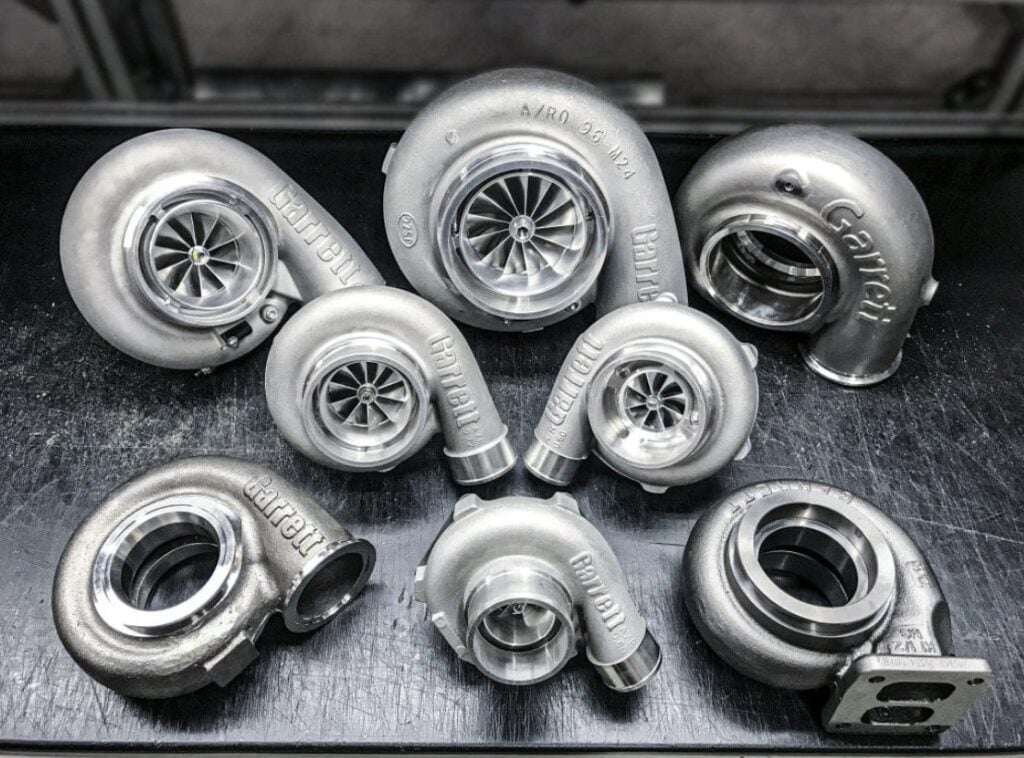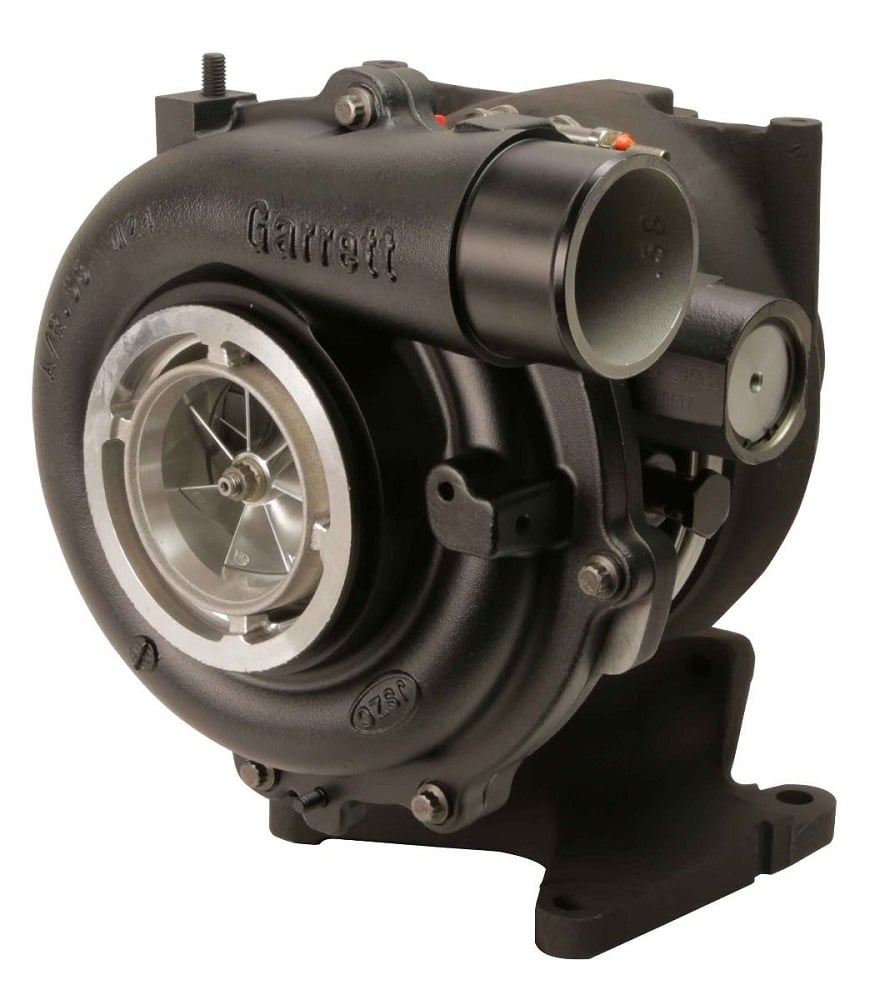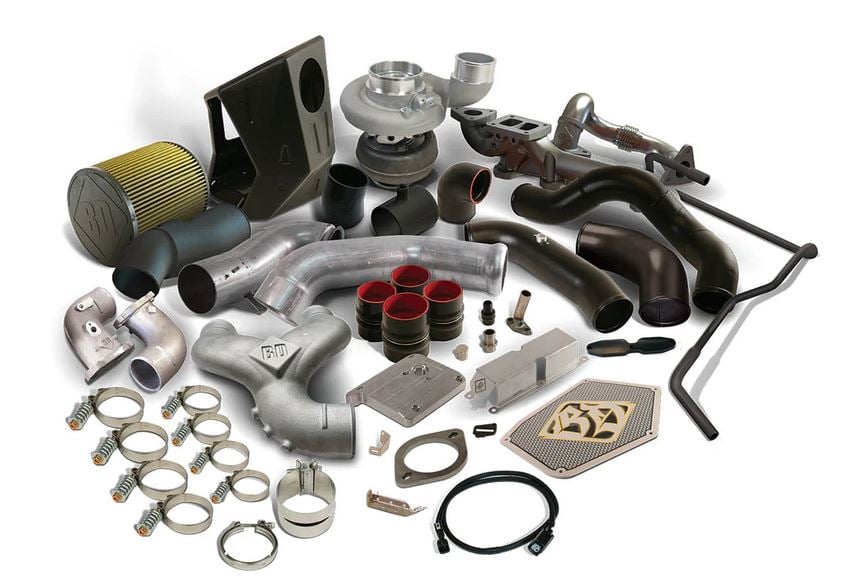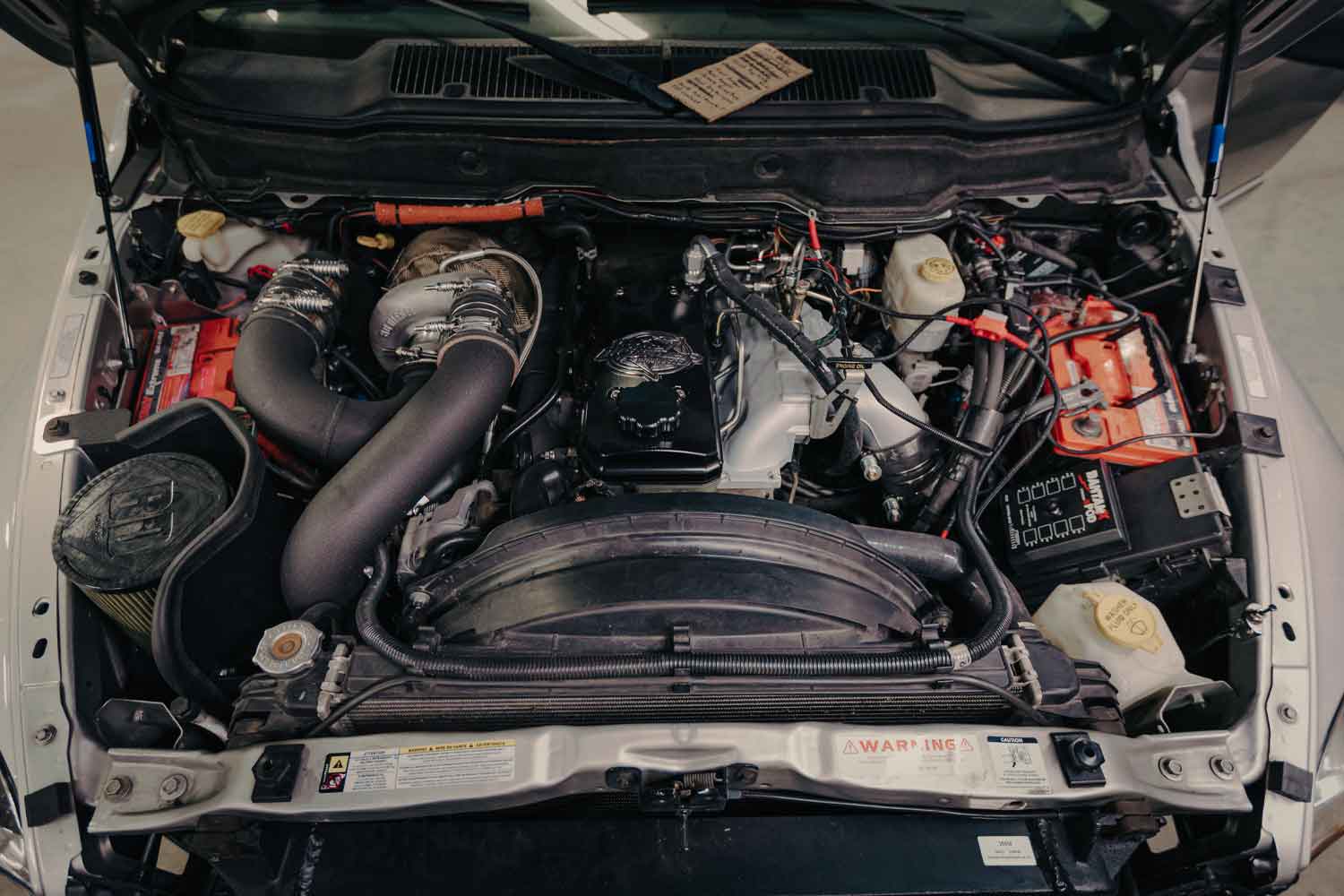Bigger is better, right? In the case of your bank account balance or a slice of your favorite dessert this may be true, but when it comes to choosing a turbo for your diesel truck, this adage doesn’t always hold water. Turbos are commonly measured in millimeters and use the diameter of the compressor wheel inducer as their size, and for an automotive application, they can range from as small as 40mm on a small 4-cylinder car to as large as 106mm on a drag racing big block. The horsepower range of those turbos will be from 150 to over 2,500 which is a giant spread, so how do you know which turbo is best for your application? To make things a bit simpler for our discussion, the average turbo size for a diesel pickup truck will usually range somewhere between 60mm to 88mm which helps us narrow things down a little, but that’s still a very broad range of power production, from about 550 to 1,500. On top of that, you also must choose between a single turbo, compound twins or even triple turbos, and then you have variable geometry or fixed vane variants as well. Needless to say, the choices can be overwhelming.
If your stock turbo has failed, or you’re planning to add more horsepower to your diesel, installing a larger turbo is a great way to increase the power potential of your engine, so it might seem to make sense to pick one that will handle 1,000hp and throw it on, right? In the real world this is a huge mistake since a turbocharger has a very narrow window where it will operate efficiently, but if you stray too far outside the efficiency zone, you will experience all kinds of problems. Simply put, your turbo must be sized correctly for your application and usage.
What Happens If Your Turbo Is Too Small?
Because a turbo is driven directly from the exhaust gas your engine produces, there is a small delay between the time you press the throttle pedal and when the turbo produces boost pressure and feeds it into the engine, and generally this delay is greater as the size of turbo increases. If you install a turbo that is too small for your engine however, it will have almost no delay and should spool up almost instantly which sounds great at first, but the drawback is a limited peak power potential. The turbine and compressor sections of a turbo each have a maximum amount of air they can flow (measured in cubic feet per minute, or CFM) and once you exceed that limit, the turbo will act as a restrictor on your engine. Additionally, when you are operating a turbo beyond its peak efficiency, the compressor side will stop producing more airflow, but start producing excessive heat.
In the real world, a too-small turbo will produce great off-idle torque and throttle response, but once you get to a medium or higher RPM, the restriction and hotter compressed air will rapidly raise engine EGT (exhaust gas temperature) and engine coolant temps to an unsafe level. If you were to operate your engine for an extended period at high loads with a too-small turbo (towing a trailer for example), the high temperatures could cause serious damage to internal parts like pistons and valves, as well as the turbocharger itself.

What Happens If Your Turbo Is Too Large?
We know that a too-small turbo is a recipe for damage, so let’s look at the opposite end of the spectrum. If you install a turbo that is too big for your intended usage, you have a similar problem, but at the opposite end of the RPM range. The turbo spool-up time will be agonizingly slow since there isn’t enough exhaust energy to move the larger turbine and compressor wheels. When you drive through town in stop and go traffic or at highway speeds on a flat road, the turbo will not be producing boost which means you need more throttle input to maintain speed. The extra fuel and low boost are a recipe for high EGT and torched parts. However, if you keep your foot planted long enough and do get your big turbo to spool up, you’ll feel a rush of power and acceleration, and you’ll notice that your EGT will be much cooler at maximum power output since the turbo won’t be working as hard. Cool EGT at max power sounds great, but unfortunately the poor street manners mean a too-big turbo is just as bad as one that’s too small.
Modifications Change Things
So far, the only variable we’ve discussed has been the size of the turbo itself, but other engine modifications can affect how a turbo reacts. The amount of air and fuel your engine consumes must be balanced to run optimally, so if you increase fueling with a larger set of injectors or a dual injection pump, you also need to increase your airflow to match, otherwise you will run into the same issue of hot EGT. A turbo that’s sized perfectly with a stock fuel system could be too small with a larger set of injectors and a hot tune. If you can only buy or install one upgrade at a time, it’s generally considered to be safer to install the larger turbo first and run it with a stock fuel system rather than running a larger set of injectors with a stock turbo.
VGT vs Fixed Vane
The last point worth mentioning before we discuss specific turbo sizes is the difference between a variable geometry turbo (VGT) and a fixed vane. Most modern diesel engines produced over the last 15 years have used variable geometry technology in the exhaust housing. There are a series of vanes (tiny air foils) that can move and direct exhaust gas to different parts of the turbine wheel. At a lower engine speed, the vanes will close which causes the turbo to spin faster and reduce turbo lag, and at higher engine speed, the vanes open and create a free-flowing exhaust housing for maximum power and lower EGT. A variable exhaust housing can help a turbocharger have characteristics of both a smaller and larger turbo at the same time, which is why the OEMs have been using them. They still have an upper and lower limit of where they can safely operate, but a VGT does have a wider range than a fixed geometry turbocharger, but the importance in choosing the correct size still applies. Want to learn more about the differences between a VGT and Fixed Vane Turbocharger, check out our in-depth article HERE.
So, What’s The Right Size Turbo for You?
The answer is “it depends”, because there is no one-size-fits-all solution, and your intended usage could mean a different turbo is best for you even though you have a similar horsepower goal as someone else. We can break it down into three to four categories that the majority of truck owners will fit in, and recommend a turbo size from there, but of course if you have questions, give the guys at Diesel Power Products a call and they’d be happy to make a specific recommendation for you.
Stage 1: The Grandpa Truck
A truck that falls into this category will be mostly (or completely) stock, with the only changes being a cold air intake or a programmer. The owner likely uses the truck for daily driving, pulling a trailer, or working in some capacity, and they aren’t concerned with extra power or performance. Likely they are looking for a new turbo because the stock one has tons of miles on it or has just worn out, and they want something that will bolt in place of their stock turbo and require no further changes to the truck. For a stage 1 build, there isn’t a need to upgrade turbo sizing over stock, although there can be benefits from a slight upgrade. For context, the stock turbo size on a 6.6-liter LML Duramax is 61mm, and a 6.7-liter Cummins uses 60mm turbo. The 6.7 Powerstroke from 2011 to 2014 used a much smaller 43mm turbo, but because it used a double-sided compressor wheel, it could move a comparable amount of air to a 60mm conventional turbo.
The best bet for a stage 1 truck will be a stock replacement turbo. Options are available like the Garrett OEM replacement turbo for the 6.7 Powerstroke and 6.6 Duramax, or a Holset stock replacement for the 6.7 Cummins. The great thing about an OEM turbo is it’s a direct bolt in replacement, and it’s made with an OEM level of quality, so you know it’s going to last for a very long time. In terms of driving characteristics, it will spool up just like your original turbo which gives great low RPM response and excellent mid-range torque for pulling a lot of weight.

If your truck falls into stage 1 but there is a chance you might be adding a few more performance upgrades in the future, you may consider stepping things up one notch. The 63mm to 64mm turbo range has quite a few drop-in upgrades a bone stock to slightly modified truck could benefit from. A drop-in turbo is a modified stock style turbocharger that will still attach to your engine using all of your factory connections, but inside has been modified to accept a larger compressor and turbine wheel, and flow more air than stock. Turbos in this category include the Fleece Cheetah (63mm version), the BD Diesel Screamer (64mm) or the Stealth 64 from Calibrated Power. Each of these turbos will deliver an increase in performance without compromising low RPM response or spool up time. While your factory turbo can support roughly 550hp (depending on the model) the 64mm drop in turbos will flow enough air to support about 650 rear wheel horsepower, while maintaining the ability to control EGT under all conditions.
It’s important to note that these 64mm drop-in turbos will work on a bone stock truck without any drawbacks or tuning changes needed, and can still be used in heavy towing applications, but in addition they can also be used with most basic performance upgrades like programmers, exhaust, intake, and so on.
Stage 2: The Dual-Purpose Truck
An owner of a stage two category pickup will have a little heavier right foot and likes to hot-rod their truck a little, and more than likely will have a few more modifications on their truck. This would include things like a programmer with a spicy tune, a cold air intake, possibly an upgraded intercooler, and more than likely tires that are a little larger than stock, and maybe a built transmission since they grenaded their first one. While stage two owners do use their truck for fun, they also need to maintain their truck’s usefulness which means it still needs to be able to produce sustained power without increased EGT and have good spool up characteristics. For a turbo in the stage two category, there are two great choices. For an easy install and a great all-around turbo, I would immediately jump to the 64mm drop-in turbos we already discussed, but there is one more great option as well.

A compound turbo kit uses two turbochargers of different sizes to create a wider range of performance than each would provide individually. A kit for a 6.7 Cummins like the ATS Aurora Plus 5000 comes with a 71mm turbo which at first sounds like it would be on the large size for a work truck, but because your stock turbo is still utilized on the manifold, your lightning quick spool up times are still retained, but with the larger 71mm turbo pushing air into your stock turbo, your overall EGT will be decreased, power will go up, and torque will go through the roof which makes a “compound over stock” turbo the ultimate towing setup. While the installation of a compound turbo kit is a little more involved than with a drop-in turbo, the ATS Aurora Plus 5000 will still work with all your original emissions equipment and can produce 600 horsepower on a stock fuel system.
Stage 3: The Weekend Warrior
Once we get to the third category, the utility of a diesel truck becomes a secondary consideration, and speed and performance take the first chair. Usually this is the type of rig that will be at stock height or maybe a bit lower to the ground, probably will have a street performance tire installed, and every modification done has only one objective: to make the truck accelerate faster. A truck in stage three likely has slightly larger injectors, a bigger injection pump, a lift pump, bigger intercooler, valve springs, an intake horn, and all the external engine modifications that are easily accessible. The 600hp goal is in the rear-view mirror, and now we’re going for something north of 700. Here, the stock and 64mm sized turbos will be just too restrictive, so we need to go to the next size which is the 67mm family. This will be the biggest size of VGT drop-in turbo that’s available, and the Calibrated Power Stealth 67 can be just the ticket for your hot street truck with applications for your 5.9 or 6.7 Cummins, 6.0 or 6.7 Powerstroke, or any model Duramax.

One more option in the Stage 3 category would be converting to a single fixed vane turbocharger. While they don’t have quite as broad of a powerband as a variable geometry turbo, for a high-performance application it’s hard to beat the free-flowing exhaust housing of a larger single turbo. BD Diesel offers a Scorpion kit for the 6.7 Powerstroke that has several turbo choices going up to 67mm, and H&S Motorsports offers an SX-E kit for a 6.7 Cummins with turbos sized up to 72mm. These options will produce excellent peak horsepower with cooler EGT, but they do take slightly more time to spool up.
Stage 4: The Racer
Once you get past 850 to 950 horsepower, you’re getting into the full-blown race truck category, and likely you’ve had your engine completely apart to install stronger pistons and rods, a performance camshaft and valvetrain, a giant fuel system, you’ve got a built transmission to handle tons of abuse, and you’ve probably got racing specific equipment like a roll cage and drag slicks. When it comes to picking your turbo size, the sky is the limit. A single S400 based 80mm turbo can produce close to 1,000 horsepower by itself, or it could be part of an even larger compound kit with a 106mm turbo to get into the 2,000-horsepower range. If you tried driving a setup that large on the street, you may be disappointed with how slowly it spools up, but once it does, you’d better be holding on.
Just Right
As it turns out, bigger is not always better and smallest isn’t always ideal, but there is a goldilocks zone for your turbo. For most owners, it’s gonna be a stock or 64mm drop-in replacement that offers the best all-around performance for their diesel pickup. These turbos are designed to work and play, and they have the best all-around performance, spool up time, EGT control, and they’re the simplest to install making them the best turbo for most applications.


I have 2003 5.9 cummins running smarty jr rebuild trans .KN dry filter. Looking to upgrade turbo for towing .What would you recommend. Thank you